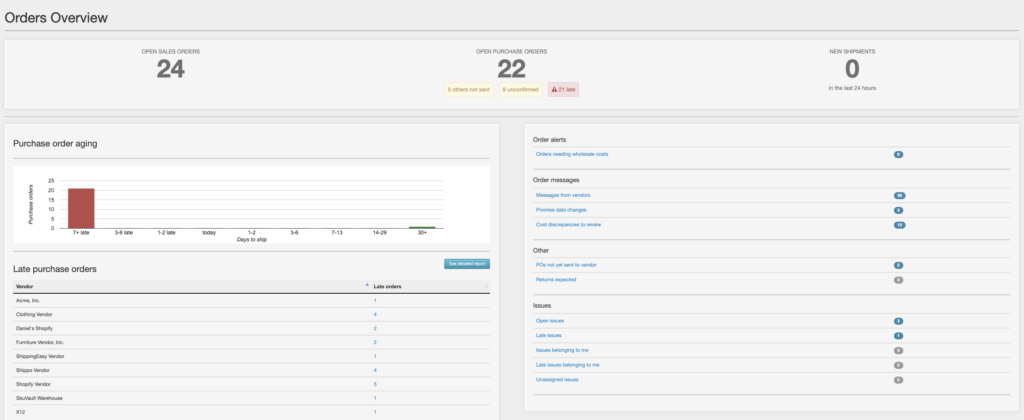
Getting Started on Duoplane for Vendors
Getting Started on Duoplane for Vendors June 19th, 2022 | 3 min read Hi Vendors, congratulations on making the best decision you’ll make all month.
Whether you’re just starting out in the e-commerce industry or you’ve been an industry veteran for years, there are always hiccups along the way. Information gets lost, data is not updated, and communication falls through the cracks – whatever the mistake may be, we’ve got you covered.
If you’re a vendor looking to prevent these critical mistakes, keep reading our comprehensive guide.
What are the Most Common Mistakes Vendors Make?
1) Not Taking a Cooperative Approach
If you take an adversarial approach to your retailer relationships, you are bound to figure yourself as competitors instead of allies with the mutual goal of providing the best experience to your end customer.
While it can be tempting to go directly to the customer and cut out your retailers, you ultimately harm your own business, because you will become your retailer’s lowest priority. Additionally, it is very difficult to direct-to-consumer (DTC).
Solution:
Figure your retailers as an extension of your own company. In turn, your retailer network will work with you and ultimately benefit you by amplifying your brand and extending your reach.
If you want to learn more about fostering and maintaining retailer relationships, check out our blog article here.
2) Not Protecting your Brand
Many vendors fall into the trap of allowing their retailers to control all aspects of their brand. In this scenario, vendors fail to monitor how their products are being presented and sold to the market.
If you are not monitoring the portrayal of your brand closely, you can miss things like outdated product photography, inaccurate pricing, incomplete descriptions, and poor site placement.
Solution:
In order to ensure that your retailers are representing your brand in the way you desire, arrange frequent check-ins. These check-ins should cover exactly how your retailers are showcasing your brand and provide market feedback. If your retailers are consistently not receiving positive market feedback, it is best to cut ties.
3) Not Being Transparent with Retailers
The main issue vendors come across is data transparency. This includes things like the lack of visibility into order status, inventory status, and shipment tracking. This can inevitably lead to problems down the line when items are sold that are not in stock, orders are left unfulfilled, and tracking numbers fall through the cracks.
Solution:
We highly suggest finding a technology solution that allows you to share data and create inventory feeds. These sophisticated systems will provide order status and tracking in a structured way, for instance, in an Excel file.
If you want to learn more about inventory feeds and why we strongly recommend using them, check out our article here.

4) Not Setting Accurate Expectations
There are several areas of business where many vendors fail to set accurate expectations. Here are a few of the most common areas of fault and how to solve them.
1. Communication
In order to avoid any confusion, it is extremely important that you let your retailers know how you would like your PPOs communicated to you and what information you expect from them on a daily, weekly, and monthly basis.
Similarly, many vendors operate using their own internal process without informing their retailers of said processes. Be sure you are your retailers are on the same page about order changes, returns, and cancellations.
2. Set a Clear Return Policy
It is no secret that no one like returns; however, the only way to relieve the burden of returns is to have an adequate system in place to handle them.
Many vendors are tempted to handle returns as they come in, but this can cause a lot of logistical and support problems. Instead, you must outline an established process with your retailer with addresses questions including:
a) Will you accept returns?
b) What is the returns process?
c) What are the criteria for accepting a return?
d) How will you notify the retailer about the return?
If you are interested in learning how returns are handled in Duoplane, check out our support article here.
3. Product
Product expectations take a variety of forms, including photography, warranty, and usage. These areas are all particularly important as they are all indicative of whether your products are being represented correctly by your retailers.
In order to ensure that your retailers are committed to you, and thus your product, we suggest working up a retailer or vendor contract. Check out this article to learn more about contracts and why they are used.
5) Making Processes too Complex for Yourself and your Retailers
There are two main reasons why vendors opt for more complex processes. They either continue to rely on old operating processes or they fall into the fallacy that more complex processes are more sophisticated.
No matter the reason, complex or arcane ordering processes require your retailers to adapt to an EDI solution unnecessarily. Similarly, many vendors fail to designate a point of contact, so there are redundant support and merchandising inquiries.
Conversely, many vendors fall into the trap of appeasing retailers at the expense of their own efficiency. If you have too many different retailers sending you orders in a variety of different formats, you will be wasting a lot of your time and your processes will be more difficult to automate later on.
Solution:
We highly suggest appointing single support and single merchandising contacts. This way, there is no confusion regarding who to contact and all responses stay consistent.
Additionally, we suggest making it easy for retailers to send and receive dating using flat, universally-accepted files. This eliminates any EDI complexities. Similarly, we suggest communicating which file format you prefer with your retailers ahead of time, so you do not need to dissect data from multiple different formats.
6) Not Investing in Scalable Tech Solutions
Any business owner knows that scalable growth is only possible with the right people and the right technology operating behind the scenes. This includes sophisticated software, an in-house development team, and automation software.
Many vendors do themselves a large disservice by rejecting technology because of a “steep” upfront cost. By relying on manual processes at a growing company, you will not only stifle your growth but also burn out your most valuable asset: your employees.
Solution:
We highly suggest working with your retailers to find technology solutions that are mutually beneficial.
At Duoplane, our main goal is to provide a seamless connection between the vendor and the retailer. You can completely automate large parts of your backend processes: order management, catalogue updates, invoice payments, and more. Duoplane organizes your order information in one place, with dashboards and alerts that tell you exactly what you need to know in real-time.
Check out this article to learn more about automating your dropship operations.

Getting Started on Duoplane for Vendors June 19th, 2022 | 3 min read Hi Vendors, congratulations on making the best decision you’ll make all month.

5 Ways to Build and Maintain Strong Retailer Relationships July 14th, 2022 | 3 min read Strong, collaborative relationships with retailers are crucial to being

We chat with Katie Ouaknine of Badgley Mischka about her experience using Duoplane. The company loves how Duoplane seamlessly integrates with BigCommerce and automates their day-to-day operations. Katie’s favorite Duoplane features include splitting orders, auto-assigning orders, and managing multi-warehouse inventory.